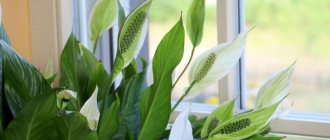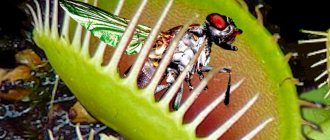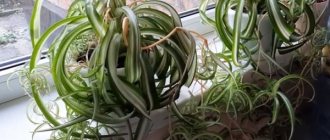What is the name of the flower “female happiness”, what does it look like?
Spathiphuillum wallisii came to Europe in 1824 from the Colombian jungle. The plant was first described by Gustavus Wallis. The researcher transferred several plant samples to Brussels, where the plants underwent adaptation and from where they began their march through the greenhouses of Europe
100 years later, Spathiphuillum wallisii has become a universally recognized favorite of amateur gardeners. In Russia the plant is known as
- Spathiphyllum/Spathiphyllum
- Sail
- Flagolist
- Woman's happiness
Description
- Evergreen stemless perennial, up to 60 cm high
- The leaves are glossy, dark green; grow directly from the soil, forming a dense bunch; leaf shape varies - from oval to elongated lanceolate
- What many people think is a white flower is actually a lance-shaped perianth (bract) wrapped around the inflorescence. The inflorescence of spathiphyllum is a spadix, the color of which varies from yellow to cream. Over time, the bracts and spadix turn green
- The plant blooms after 6 months of growth. Each flower lasts 5-6 weeks
Flower Women's happiness: how to care for it to bloom
Blooming spathiphyllum
To stimulate the appearance of new flowers, the peduncle with a wilted cob and spathe is cut off with a sharp knife or pruning shears. This should be done as close to the ground as possible
The flowering of spathiphyllum is also affected by light, temperature, air humidity and the size of the flower pot.
Illumination
In summer there is partial shade, in winter there is full light. Never keep the plant in direct sun. Considering the natural habitat of Spathiphuillum wallisii - the herbaceous layer of the tropical forest - it is not surprising that the plant prefers diffused sunlight and feels great near windows facing north
General care
Wipe the leaves with a damp sponge and do not use flower polish.
Temperature
In winter - no lower than 13⁰С, optimal temperature - about 16-18⁰С. In summer - within 18-21⁰С. The higher the temperature, the higher the humidity should be
Important: the plant is afraid of drafts! Even in summer!
Humidity
At temperatures above 21⁰C, the plant requires daily spraying.
The rest of the time:
• in winter - 2 times a week
• in spring and autumn (at a temperature of 15-20⁰С) - 3 times a week
Advice. If, due to some circumstances, you cannot provide the plant with daily spraying, place the pot with the plant in a container (tray) with wet expanded clay or pebbles. Make sure that the bottom of the pot does not touch the water to avoid waterlogging of the soil.
Pallet with pebbles for indoor plants (design options)
Flower pot size
Abundant flowering occurs only after the root system of the plant has entwined the entire pot. Experienced flower growers say: “The tighter the pot, the more colorful the flower” and this simple truth applies to all flowering indoor plants
Spathiphyllum is Women's Happiness
The homeland of spathiphyllum is Venezuela, Thailand, Philippines, southern USA, Brazil. Popular wisdom says that this plant can help a lonely girl find love and become a happy wife, but its miraculous power manifests itself only during the flowering period.
Description of the plant
This is a plant with dark green elongated leaves and beautiful inflorescences, which are a white ear, which is covered with an oval veil, reminiscent of a bride's dress.
That is why it is also called “Women’s Happiness”. Spathiphyllum belongs to the Araceae family and has more than 45 species. The genus name is derived from the Greek words "spa" and "phyllum", which translates as "spread" and "leaf". This is a useful plant: it absorbs harmful substances from the air in the room, saturates it with phytoncides and suppresses the spread of mold fungi. It takes root well and is completely unpretentious in care, so even novice gardeners love it. But for normal growth and beautiful flowering, a number of rules must be followed.
Ads by
Growing conditions
Loves
- abundant watering
- high air humidity
- diffuse light
- spraying
Does not love
- direct sunlight
- drafts
- cold water for irrigation
Planting, transplanting and propagation
The plant needs to be replanted when it becomes very crowded in its house. Spring time is ideal for this. Spathiphyllum reproduces by dividing the bush or by shoots. To make the plant take root faster, it is better to cover it with a plastic bag to create a kind of greenhouse.
Watering and fertilizing
The leaves should be wiped with a damp cloth or given a warm shower. It is better to water it with settled or rain water. For abundant and frequent flowering, it must be fed with fertilizers once every two weeks.
Features of cultivation
During the period of growth and flowering, the plant needs a lot of light, but it should be shaded from direct sunlight.
Ideally, place it not on the windowsill, but on a stand by the window. Temperature in summer is +20…+22 °C, in winter not lower than +12 °C. My spathiphyllum blooms almost all year round, but from October to January it should have a dormant period. For planting, choose pots that are a little cramped for it: in a deep and wide pot, the plant will not bloom soon: don’t wait until the root system fills the pot.
Spathiphyllum has enemies in the form of spider mites, scale insects or aphids. Soapy water or tobacco infusion helps get rid of them. I avoided this fate, the plant is alive and healthy.
It may hurt. This is mainly due to violation of watering rules. Leaves have turned black - this is a sure sign of overwatering and root rot, especially in winter. Dried and yellowed leaves are due to underwatering and dry air. The plant may suffer from an overabundance of fertilizers, in which case brown or black spots will appear on the leaves.
How to water the flower of Women's Happiness?
• In summer - 2-3 times a week
• In winter - once a week
Important: Water for irrigation should be at room temperature
Do not use distilled, bottled or filtered water. Regular tap water is a perfectly suitable liquid for watering indoor plants.
With some caveats:
- Before watering, the water should stand for 24-48 hours. In this case, the liquid must be in an open container. This will allow chlorine to evaporate, which, unfortunately, is present in tap water.
- aroid plants, incl. spathiphyllums react poorly to hard water
The effect of hard water on indoor plants
How to soften water for watering indoor plants?
The proportions are given for 1 liter of ordinary tap water. Choose the option that suits you
- 0.1-0.2 g oxalic acid
- 3 g wood ash
- 2-3 drops of vinegar (9%)
- 0.3-0.4 g citric acid
- 0.1 ml sulfuric acid
- 2-3 drops of lemon juice
Add the selected substance to the water and leave to settle
Important: do not use boiled water (even at room temperature) for irrigation! Exposure to high temperatures deprives water of dissolved air. The use of such water can also cause putrefactive processes in the root system of the plant.
Care
Many novice flower growers do not know how to care for the flower of female happiness. But the whole secret is that caring for spathiphyllum at home contains a minimum of instructions. When growing spathiphyllum, it is important to follow replanting and fertilizing schedules, temperature conditions and maintain air humidity. And also do not forget about regular watering of spathiphyllum.
Soil selection
Soil for spathiphyllum can be purchased at the store or prepared yourself. Neutral and slightly acidic soils with good air and moisture permeability are suitable for women's happiness.
Soil composition:
- vermiculite or coarse sand;
- peat;
- turf land;
- leaf soil;
- charcoal or ash;
- drainage made of expanded clay, broken brick or foam.
Female flowers are undemanding in terms of composition, but will grow poorly in heavy and non-nutritious soils.
The soil should be saturated with useful microelements and organic substances.
Location and lighting
Women's happiness is a light-loving, southern culture and it simply needs long daylight hours to bloom. But direct sunlight can leave burns on delicate leaves, so in the summer it is best to place pots on window sills with diffused lighting. Windows facing west or east are also suitable.
On northern windows, the plant will not have enough light, which is why the leaves will fade, become deformed and stretched, and flowering will never occur.
Temperature
Spathiphyllum grows well at home in a temperature range from + 20 to +25 ° C. But it should be remembered that women’s happiness needs to be watered abundantly in summer and spring, since high temperatures contribute to the drying out of the earthen coma. You also need to remember about air humidity and on hot days constantly spray the plant with a spray bottle.
How to care for spathiphyllum in winter? Starting in November, the plant needs to be gradually transferred to dormancy mode. To do this, the temperature should be lowered to +14 +16 °C and watering should be reduced. The “rest” period should last until the onset of the first warming. Around the end of February, the temperature should be gradually increased, bringing the indicators to the summer regime.
Watering
When faced with an exotic crop for the first time, beginners do not know how often to water spathiphyllum and how to water spathiphyllum. Most gardeners advise watering the flower through a tray or over the top. It is better to use settled or filtered water, as the plant reacts negatively to chlorine and other heavy compounds.
How to water a flower of female happiness:
- In hot weather, watering the flower should be done every other day or daily, depending on the air temperature and the rate of drying of the soil.
- Small pebbles in the pan and a cool shower will help maintain moisture. After a shower, the plant can not be watered for 2-3 days.
- In winter, exotic plants are watered twice a week.
How to water spathiphyllum directly depends on the temperature and humidity of the earthen clod. If it is hot outside and the earthen lump has retained moisture, it is better to reschedule the procedure. Frequent watering can lead to souring of the roots, and this is as dangerous as drying out, so it is necessary to comply with the norm.
Fertilizers
Fertilizer for flowering plants
The indoor flower spathiphyllum, like other indoor flowers, needs regular soil fertilization. This does not apply to young and recently transplanted plants. It is recommended to feed the flower of female happiness after the completion of the first period of winter dormancy. During the winter dormant period, fertilizing is excluded or applied at intervals of at least 1 month.
How and when to feed:
- Not earlier than 2–3 months after purchase.
- Do not fertilize a plant that is sick or infested with pests.
- Before feeding the flower, water it.
- Liquid, root compounds should not get on the foliage.
- The plant is not fed after illness and transplantation for 2–4 months.
A properly designed feeding schedule is the key to a healthy and strong plant.
How to feed the flower of female happiness:
- Complex compositions for aroids.
- When spathiphyllum blooms, it needs fertilizers containing potassium and phosphorus.
- Universal compositions for indoor flowering plants.
Fertilizers that contain large amounts of nitrogen should be avoided. Since after applying such compounds, the plant will not bloom, but will begin to increase green mass.
Transfer
Before replanting, you need to know how to properly prepare the plant and what kind of pot is needed. For the flower of female happiness to bloom and grow actively, it needs a pot that exceeds the volume of the root pot by only 3–5 cm.
If the container is large, the spathiphyllum will not bloom until its roots fill all the free space.
After purchase, you need to give time to adapt to the climate of the apartment. A plant can be replanted immediately only if it is very cramped in the pot or there are other indications.
Plant root system
Transplantation:
- The best period for replanting occurs when the plant comes out of winter sleep.
- The flower is watered abundantly the day before the procedure.
- Carefully remove the plant, holding it at the base.
- The new pot should have drainage holes, a layer of expanded clay and a small layer of soil.
- The bush is placed in the center of the pot and sprinkled.
- Only the roots are buried so that the growing points remain above the soil surface.
Flower growers recommend using the transshipment method, since the root is very fragile. But if you need to plant a flower or inspect the roots, then the soil is removed.
How to plant spathiphyllum? The entire procedure repeats the transplantation method except for some points.
Seating:
- An adult plant is not watered for a week.
- Then remove the roots from the pot and carefully shake out the contents.
- Divide the bush into the required number of seedlings.
- The roots are treated with an antifungal and antiseptic drug.
- Next, each seedling is placed in an individual pot and replanting instructions are followed.
How to care for spathiphyllum after transplantation? The transplanted plants are sprayed with water and watered a little. The pots are placed on illuminated windowsills and the temperature is maintained in the range from +20 to +25 °C. Further care of the plant is no different from caring for adult crops.
Care and transplantation. Video
Trimming
Flower growers recommend removing flower stalks and dead leaves. There is no need to trim living leaves.
Wintering
Caring for women's happiness in winter includes lowering the temperature to +14 +16 °C, reducing watering and reducing light levels. The plant should be kept in this state from November to the end of February.
Earth for a flower Women's happiness
The ideal soil for the plant is a mixture consisting of 1 part fertile clay soil and 1 part coarse sand (not construction or marine)
Most companies specializing in the production of soils and substrates for indoor plants, as a rule, indicate on the packaging information about which plants the soil mixture is formulated for. Feel free to purchase a substrate formulated for aroid or flowering tropical plants.
Soil for spathiphyllum
Types and varieties
It is no secret that breeders are constantly working on developing new varieties and types of indoor plants. Therefore, the spathiphyllum flower already has more than 20 varieties that are suitable for growing on windowsills. Caring for spathiphyllum at home is simple and even a beginner can handle all the procedures. Therefore, the future gardener can only choose the appropriate variety from the photo and read a minimum of information about the plant.
Flower growers advise paying attention to unpretentious species, such as spathiphyllum Strauss or Bellini. These varieties are distinguished by long flowering in summer, abundant foliage and strong immunity. Below in the article we describe what the most popular varieties of spathiphyllum look like.
Spathiphyllum cannifolium spathiphyllum cannifolium
This variety of spathiphyllum has beautiful glossy leaf blades of a rich green color. The shape of the leaves is oval, slightly elongated towards the edge. In the center of the leaf there is a well-defined vein with branching lateral veins. The species received its name due to the similarity of the shape of the leaf blades with the canna flower.
The plant of female happiness blooms twice a year, the opened buds have a pleasant, spicy aroma.
Spathiphyllum spoon-shaped spathiphyllum cochlearispathum
Spathiphyllum this variety has long leaves from 31 to 42 cm, which grow from dense petioles one or several pieces at a time. The petioles are strong, rounded, length from 63 to 74 cm. The maximum height of an adult plant does not exceed one meter.
The leaf blades are oval-elongated, with a glossy, bright green surface. The variety blooms in spring and summer. The cob and spathe are snow-white.
Spathiphyllum floribundum
This variety of spathiphyllum is characterized by abundant flowering and a height of 42 to 53 cm. The leaf blades are oblong-oval in shape with a pointed edge, glossy, dark green in color. The central vein is slightly lighter than the main color, therefore more clearly expressed than in other varieties.
One white flower is formed on the peduncle; as it grows, the spathe changes color to greenish.
The size of the bedspread is from 11 to 14 cm, the cream cob is from 18 to 23 cm.
Good to read: Lily is a royal flower, a serious competitor to roses.
Spathiphyllum lovely spathiphyllum blandum
This spathiphyllum differs from others in the shape of its leaf blades. The leaves are oval and elongated at the edges, the edge is slightly bent inward, which is why the plate resembles a miniature boat. The edge of the leaf is pointed, the color is rich green. Flowering begins in April and ends with the arrival of cold weather. The plant produces up to 3–6 peduncles at a time. On each peduncle a pale green flower with a white or yellowish spadix is formed.
Spathiphyllum wallisii spathiphyllum wallisii
The height of an adult spathiphyllum of this variety can reach up to 33 cm. The leaf blades are dark green in color, about 22 cm long, 5–6.5 cm wide. The shape is oblong oval with a pointed edge, the surface is glossy. The cob is white, the spathe is cream or snow-white.
Read about which plant has beneficial properties here.
Review of spathiphyllums. Video
Flower Women's happiness: how to replant
The plant should be replanted immediately after purchase. Then the spathiphyllum needs to be replanted every 3-5 years
The need to move the flower to a freer pot is indicated by the root system of the plant protruding to the surface
Flower growers recommend replanting plants in the spring, which is associated with the natural biological rhythms of flowers. But spathiphyllums have slightly different rules and requirements. The main condition is the air temperature within +20⁰С (not lower!), and the time of year does not matter.
So,
- Prepare a pot for replanting. Its diameter should be 2-3 cm larger than the diameter of the previous flowerpot. Be sure to pour boiling water over the inside of the flowerpot
Interesting: Feng Shui experts recommend using round-shaped flowerpots in metallic color for spathiphyllums.
- Carefully remove the plant from the previous pot. To simplify the extraction process, wet the soil in the flower pot well
Removing spathiphyllum from a flowerpot
- Be sure to free the plant roots from drainage (if used) and soil residues
Freeing roots from drainage and soil
- Unfortunately, the flower stalks need to be cut off. This will allow the plant not to waste time and energy on flowering and setting seeds.
Removing flower stalks
- Leaves that are too young and those that are beginning to wilt must be removed. Brown, scaly remains of the bases of old leaves also break off
Trimming leaves and removing the bases of old leaves
- Be sure to carefully examine the root system of the plant. Root threads that are too long and areas with signs of rot should be pruned. Sprinkle the root sections with powdered activated carbon or cinnamon.
- Check that the flowerpot you choose has through holes at the bottom (such holes serve as a kind of drainage system). Another prerequisite for the flowering life of a plant: the presence of a drainage layer at the bottom. Drainage may consist of small pebbles, brick fragments or expanded clay. The latter can be purchased at any store specializing in the sale of indoor plants. The thickness of the drainage layer is 1.5-2 cm. And only now can soil substrate be poured into the flowerpot (half the volume of the flowerpot)
- Place the plant in the center of the container. Try to evenly distribute the roots of the spathiphyllum, filling the entire surface of the soil. Cover the plant's root system with the remaining soil
Distribution of spathiphyllum roots during transplantation
- Note! In its natural habitat, spathiphyllum has a developed system of aerial roots. Aerial roots are also present in indoor plants. There is no need to dig them deep into the soil!
Left: what the aerial roots of spathiphyllum look like. Right: position of aerial roots when transplanting the plant correctly
- Lightly compact the soil substrate. Check that the flower rosette is securely fixed in the ground. Water the soil well. During the first heavy watering, it usually settles. To compensate for subsidence, add a little more soil to the flowerpot.
Flower Women's happiness: how to replant
- After transplantation, pamper Women's happiness with spraying
Care after transplant
Tip: if you can’t wait to see the spathiphyllum blooming again, give it a mini-greenhouse. Wrap the flower in transparent polyethylene to prevent rapid evaporation of moisture and create an ideal microclimate. Water and spray the flower as usual
Mini-greenhouse for spathiphyllum
Advice: it is better to replant flowers during the waxing moon
How to make spathiphyllum bloom
Women's happiness may not throw out new buds for various reasons. Sometimes you just need to wait and let the plant rest or recover from replanting. But much more often, owner intervention is required.
Normalization of growing conditions
For spathiphyllum to bloom, it is often enough to adjust the care and place the pot in a suitable place:
- Spraying and watering with warm water stimulate flowering. Buds are laid only in high humidity.
- After leaving the dormant period, nitrogen should predominate in fertilizing. When the leaves begin to grow and become stronger, you can reduce nitrates and increase the proportion of potassium and calcium - this fertilizer promotes the formation of buds.
- In order for spathiphyllum to bloom well every season, replanting should be done annually.
- The crop should be watered abundantly, but not excessively, so that the soil is moist and the water does not stagnate in the pot.
- At temperatures from 20 to 27° C, spathiphyllum will bloom faster.
- The plant needs bright diffused light without direct sunlight for 10-12 hours a day.
- As soon as the blanket begins to turn green, it needs to be cut as short as possible.
Forced rest period
Spathiphyllum can be forced to bloom due to the stress it experiences when its contents change. When conditions are close to ideal, you will have to resort to trickery. For example, send it into hibernation for 3-4 weeks, especially since the plant cannot bloom continuously - it needs to rest.
Step by step:
- Trim off all flower stalks. If there is a need to stimulate the formation of buds, then their quality and quantity leave much to be desired.
- Place the pot in light partial shade, where women's happiness will be illuminated only 6 hours a day.
- Stop feeding.
- Reduce watering to a minimum - before watering, the leaves should droop a little, but under no circumstances droop.
- Do not spray the plant.
- Reduce temperature to approximately 16°C.
It is better to arrange a forced dormancy period at the end of the season - this coincides with the biological rhythms of the plant. Growth processes slow down naturally, it tolerates stress more easily.
Then the spathiphyllum is returned to a warm, well-lit place, they begin to water and spray, and give complex fertilizers. In about a month, the first blankets should bloom.
Women's happiness (flower): reproduction
The flower of female happiness multiplies by division. This means that flower transplantation is completely compatible with propagation
After removing the plant from the pot, you should carefully and slowly divide the main rosette of the plant into several sections. Make sure each one has a viable section of root system
Spathiphyllum propagation
Next, follow the tips described in the previous part of the article.
Reproduction of spathiphyllum
In its natural habitat, the Flower of Love reproduces by seeds. This method is usually used by breeders involved in breeding new varieties. In indoor conditions, amateur gardeners most often use cuttings or dividing bushes.
The right moment for replanting is an overgrown plant that has become cramped in its pot. The procedure is quite simple and consists of several steps:
- Before removing the bush from the container, it needs to be watered.
- Clean the roots from the soil and rinse carefully in clean warm water.
- Remove unnecessary shoots.
- Separate the roots, carefully untangling them. If this cannot be done with your hands, resort to using a knife. The sections are immediately sprinkled with crushed activated carbon to prevent the entry of bacteria.
After this, the shoots are planted in new containers. Cuttings of spathiphyllum without roots can be dipped in water. The rooting process carried out in this way will take from 2.5 to 3 weeks.
Experienced flower growers, knowing how much happiness spathiphyllum brings to the house, claim that growing it at home is a great joy.
Flower of female happiness: leaves turn yellow and black
Appearance of a “sick” spathiphyllum
Yellow and black leaves indicate two completely different problems. And the solutions to these problems are different.
- Yellow leaves of the plant indicate too much bright sunlight in your pet's life. Provide the plant with partial shade and everything will work out
- Sometimes yellow leaves may indicate a red spider mite infestation. In this case, a cobweb may appear on the back side of the leaf plate. Be sure to treat the plant with a systemic insecticide, which can be purchased at flower shops
Important: If you have a lot of plants, you will have to process them all!
- Pay attention to which leaves turn yellow, old or young. For older leaves, yellowing is part of the natural dying process.
- The appearance of dry black tips on the leaves indicates insufficient moisture. Unfortunately, in a city apartment this is a common phenomenon even if the plant is frequently sprayed
- Blackening, which affects a large area of the leaf, may indicate hypothermia of the root system (especially in winter), excess moisture in the soil (overwatering), overfeeding with fertilizers
Why does the flower of Women's Happiness wither?
Wilted spathiphyllum
- Many gardeners make the same mistake: they overdry the earthen ball. By watering a flower in the generally accepted way (from above), you only moisten the top layer of soil. This may not be enough for the normal life of the plant, because the main root system is located below. And moisture may not reach the lower layers of the earthen coma. That is why the soil in flower pots is moistened in a very interesting way: simply place the container with the flower in a bucket or deep bowl of water. Thus, the soil is moistened from the bottom up, saturating the plant’s root system and drainage layer with moisture. A sign of sufficient moisture saturation is the formation of a moist halo around the flower rosette.
- Another reason for the wilting of spathiphyllum is saturation with moisture and, as a consequence, the occurrence of rotting of the roots. The main sign indicating rotting of the root system is constantly moist soil (even with infrequent watering). The plant needs to be replanted immediately! How to do this is described at the beginning of the article.
How to save a flower Women's happiness. Flower female happiness illness
In addition to the above recommendations, take into account that the plant may also suffer from a deficiency or excess of certain microelements, as well as be infested by pests
Causes and signs of plant diseases
First determine the cause of the disease and only then take measures to save the plant
Flower Women's happiness: signs and superstitions
Spathiphyllum has become a worthy successor to the once popular calla lily. Along with its popularity, spathiphyllum also inherited magical properties.
- The flower is considered to be a female amulet, capable of not only protecting its owner and her home from all sorts of troubles and misfortunes, but also helping to make the right decisions.
- Esotericists say that spathiphyllum should be in marital bedrooms and children's rooms, since the energy of the flower strengthens family ties
- There is an opinion that the plant helps a woman become more confident and attractive, awakening hidden energy reserves in her











